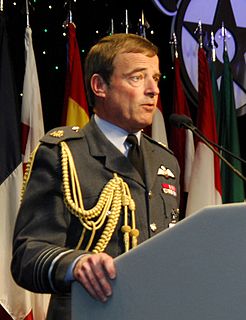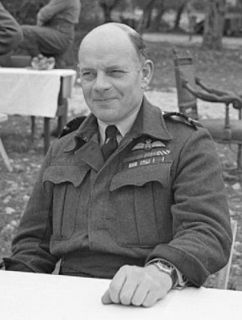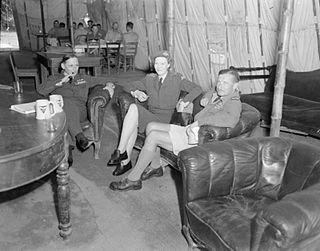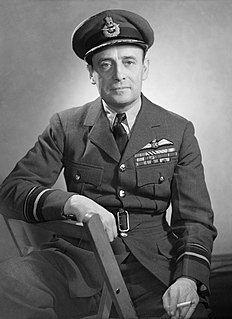
Air Chief Marshal Sir Glenn Lester Torpy, is a retired senior Royal Air Force commander. He was a fast jet pilot in the late 1970s and 1980s, saw active service during the Gulf War and then went on to higher command. He was the air component commander on Operation Telic and served as Chief of the Air Staff, the professional head of the RAF, from 2006 to 2009. In that role Torpy hosted the RAF's biggest air display in two decades, and argued for consolidation of all British air power in the hands of the RAF.

Marshal of the Royal Air Force Sir William Forster Dickson, was a Royal Naval Air Service aviator during the First World War, a senior officer in the Royal Air Force during the inter-war years and a Royal Air Force commander during and after the Second World War. Dickson was Chief of the Air Staff in the mid-1950s, in which role his main preoccupation was the establishment of the V Force and the necessary supporting weapons, airfields and personnel. He also served as the first Chief of the Defence Staff in the late 1950s.

Air Chief Marshal Sir James Milne Robb, was a senior Royal Air Force commander. After early service in the First World War with the Northumberland Fusiliers, Robb joined the Royal Flying Corps and became a flying ace credited with seven aerial victories. He was granted a permanent commission in the Royal Air Force in 1919 and commanded No. 30 Squadron RAF in the Iraqi revolt against the British. In 1939, Robb travelled to Canada to help establish the Empire Air Training Scheme, a massive training program that provided the Royal Air Force with trained aircrew from Canada, Australia, New Zealand and Southern Rhodesia. He commanded No. 2 Group RAF of RAF Bomber Command and No. 15 Group RAF of RAF Coastal Command.

Air Commodore Lionel Evelyn Oswald Charlton, was a British infantry officer who served in the Second Boer War. During the First World War, Charlton held several command and staff posts in the Royal Flying Corps, finishing the war as a brigadier general. Transferring to the Royal Air Force on its creation, Charlton served in several air officer posts until his retirement from the air force in 1928. Most notably, Charlton resigned his position as the RAF's Chief Staff Officer in Iraq as he objected to the bombing of Iraqi villages.

Air Chief Marshal Sir Charles Stuart Burnett, was a senior commander in the Royal Air Force during the first half of the 20th century. He was Air Officer Commanding Iraq Command during the early 1930s. During the Second World War, he served as Chief of the Air Staff of the Royal Australian Air Force.
Air Marshal Sir John Frederick Andrews Higgins,, known as Jack Higgins, was a senior officer in the Royal Flying Corps, serving as a brigade commander from 1915 to 1918. After the First World War he served in a range of senior posts in the Royal Air Force until his retirement in 1930. He returned to active service for the first year of the Second World War.
Air Commodore Graham Clarke Bladon was a British air officer of the Royal Air Force, who initially joined the Royal Naval Air Service during the First World War, becoming an RAF officer in 1918. He went on to hold various commands up to and throughout the Second World War, and served as the first Commander of the Royal Ceylon Air Force from 1951 until 1958.

Air Commodore Richard Charles Montagu Pink CBE was a senior officer in the Royal Air Force. He distinguished himself during service with the Royal Navy and Royal Naval Air Service in World War I, before joining the Royal Air Force shortly after its creation in 1918. He is the namesake of Pink's War, which was the first campaign conducted by the RAF alone and the only campaign to be named after an RAF officer.

Air Chief Marshal Sir Robert Mordaunt Foster, was a Royal Flying Corps pilot in the First World War, and a senior commander in the Royal Air Force during the Second World War and the immediate post-war years.

Air Commodore Robert Marsland Groves, was a Royal Navy officer involved with naval aviation during the First World War. He was awarded his Aviator's Certificate no. 969 on 15 November 1914. After transferring to the Royal Air Force in 1918, he served as Deputy Chief of the Air Staff and held high command in the Middle East. He was killed in a flying accident in 1920 aged 40 whilst serving in Egypt.
Air Commodore Robert Gordon, was an early British military aviator. As a Royal Marines officer he held various posts in the Royal Naval Air Service during the First World War. From 1918 onwards, he was a senior officer in the Royal Air Force. He notably commanded the RAF's Z Force in British Somaliland in 1920 as part of the Somaliland campaign.
Air Chief Marshal Sir Michael James Douglas Stear, is a retired senior commander of the Royal Air Force (RAF). He served as Deputy Commander in Chief, Allied Forces Central Europe from 1992 to 1996.

Air Commodore John William Boldero "Jack" Grigson was a highly decorated British pilot who served in the Royal Naval Air Service and Royal Air Force in World War I, continuing his service and serving in World War II until his death in an air crash in 1943.

Harry George Smart, is best known as the commander of RAF Habbaniya during the first part of the Anglo-Iraqi War. Smart was an officer in the British Army, the Royal Flying Corps and the Royal Air Force. He served during the First World War, during the interwar period, and during the Second World War.

Air Commodore Barbara Cooper, CBE is a retired British Royal Air Force officer and former Commandant of the Air Cadet Organisation (ACO). She was promoted to Air Commodore in 2008 and became the RAF's highest-ranking female. She became the Assistant Chief of Staff (Manning) at Air Command headquarters. She previously served at the tri-Service military Defence Academy in Shrivenham as Division Director.
Air Vice Marshal Colin Peter Brown & Bar was a Scottish officer who began his career in the Royal Naval Air Service during the First World War, before transferring to the Royal Air Force (RAF). A flying ace credited with 14 aerial victories, he remained in the RAF and served throughout the Second World War, retiring in 1954.
Air Vice Marshal George Stacey Hodson, was an air officer of the British Royal Air Force who began his military career as a World War I flying ace credited with ten aerial victories. In the course of his 34 years service, he rose to become a major commander during World War II.
Air Commodore Thomas Charles Reginald Higgins, was an early British aviator and senior Royal Flying Corps commander during the First World War.
Air Vice-Marshal Ian Duguid is a senior Royal Air Force officer in command of No. 11 Group RAF headquartered at RAF High Wycombe in Buckinghamshire. Duguid was a harrier pilot and Typhoon Force Commander before assuming the role of the air officer commanding (AOC) No. 11 Group.















